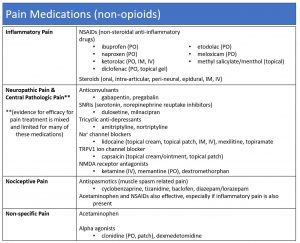Acute pain is a normal response to injury or physical or physiological stress, and it is protective. Acute pain can be nociceptive or inflammatory (see below). Acute pain is relatively short-lasting in duration. Acute pain can be mild, moderate, or severe in intensity. Acute pain can wax and wane, come and go, or be constant. Treatments for acute pain should target the pain type and should be of short duration.
Chronic pain is pathological. It is an abnormal response, no longer a protective response. Chronic pain may resolve, lessen over time, wax and wane, spread, worsen, or may be permanent. Chronic pain is a disease state that can be managed like other disease states (diabetes) with treatments designed to target the source and lessen the symptoms. Treatments should focus on lessening the progression (prevention) and on improving function as primary goals. Both acute pain and chronic pain can exist together.
There are 3 main pain types (review the table below for the details of each type). It is helpful to understand what these are so that the treatment can be targeted to the type of pain (see the table below for non-opioid pain medicines that target specific pain types). Treatment can be more effective when it targets the pain type (i.e. choose medicines or therapies that treat the type of pain).
Broadly, the 3 pain type categories are:
- Nociceptive pain
- Inflammatory pain
- Pathologic pain
References:
- Kent ML, Tighe PJ, Belfer I, et al. The ACTTION-APS-AAPM Pain Taxonomy (AAAPT) Multidimensional Approach to Classifying Acute Pain Conditions. Pain Med. 2017 May 1;18(5):947-958.



